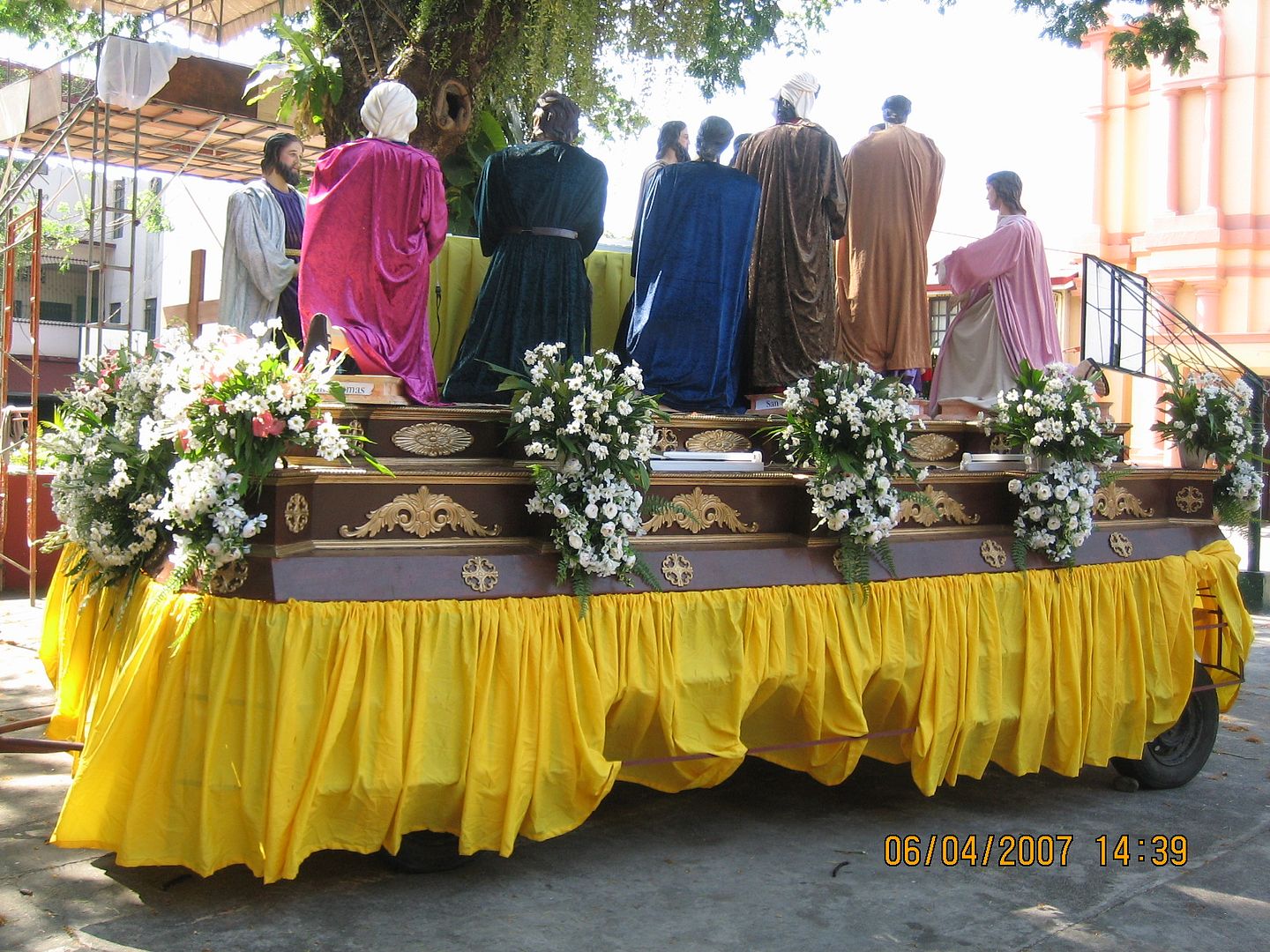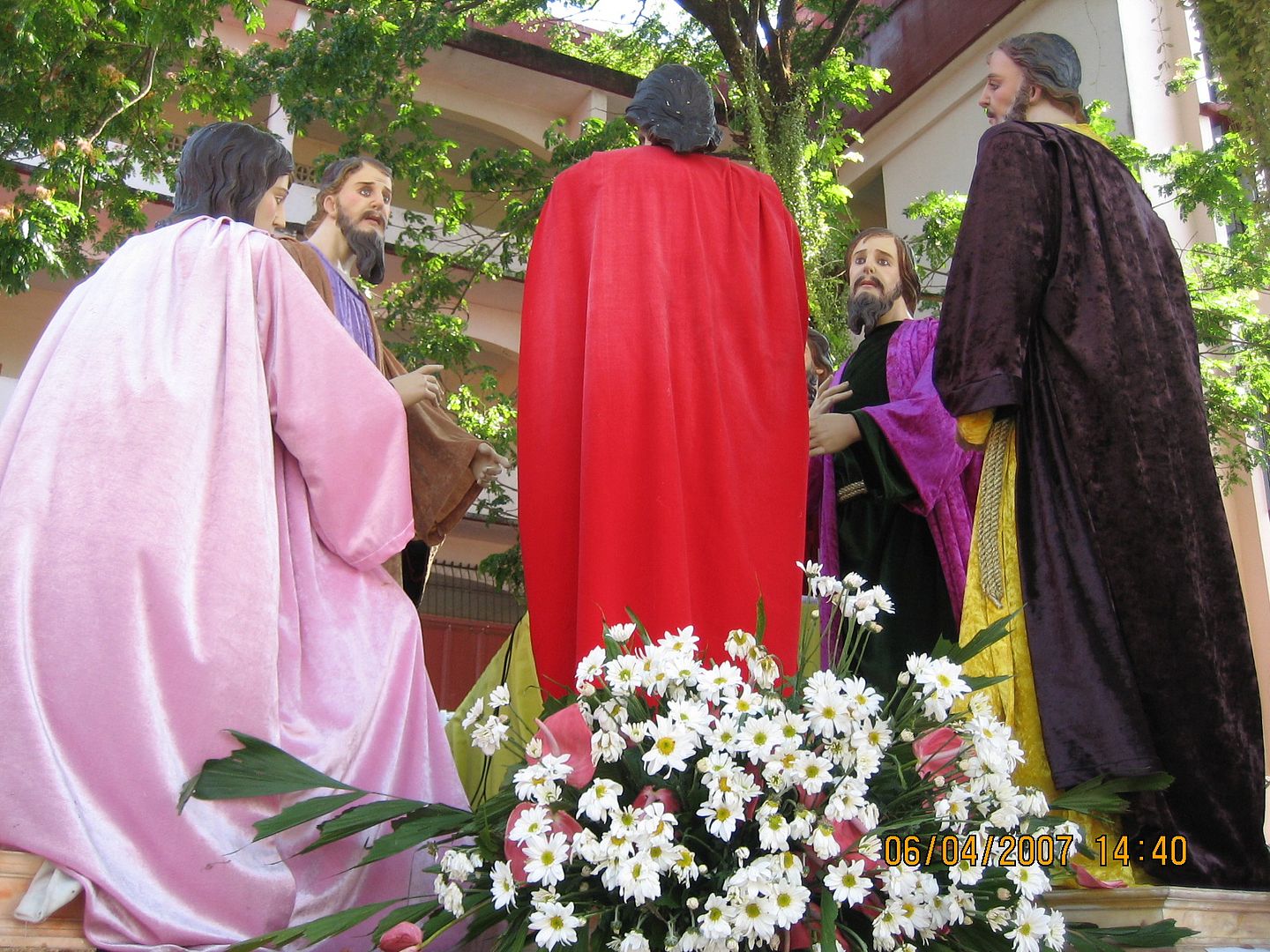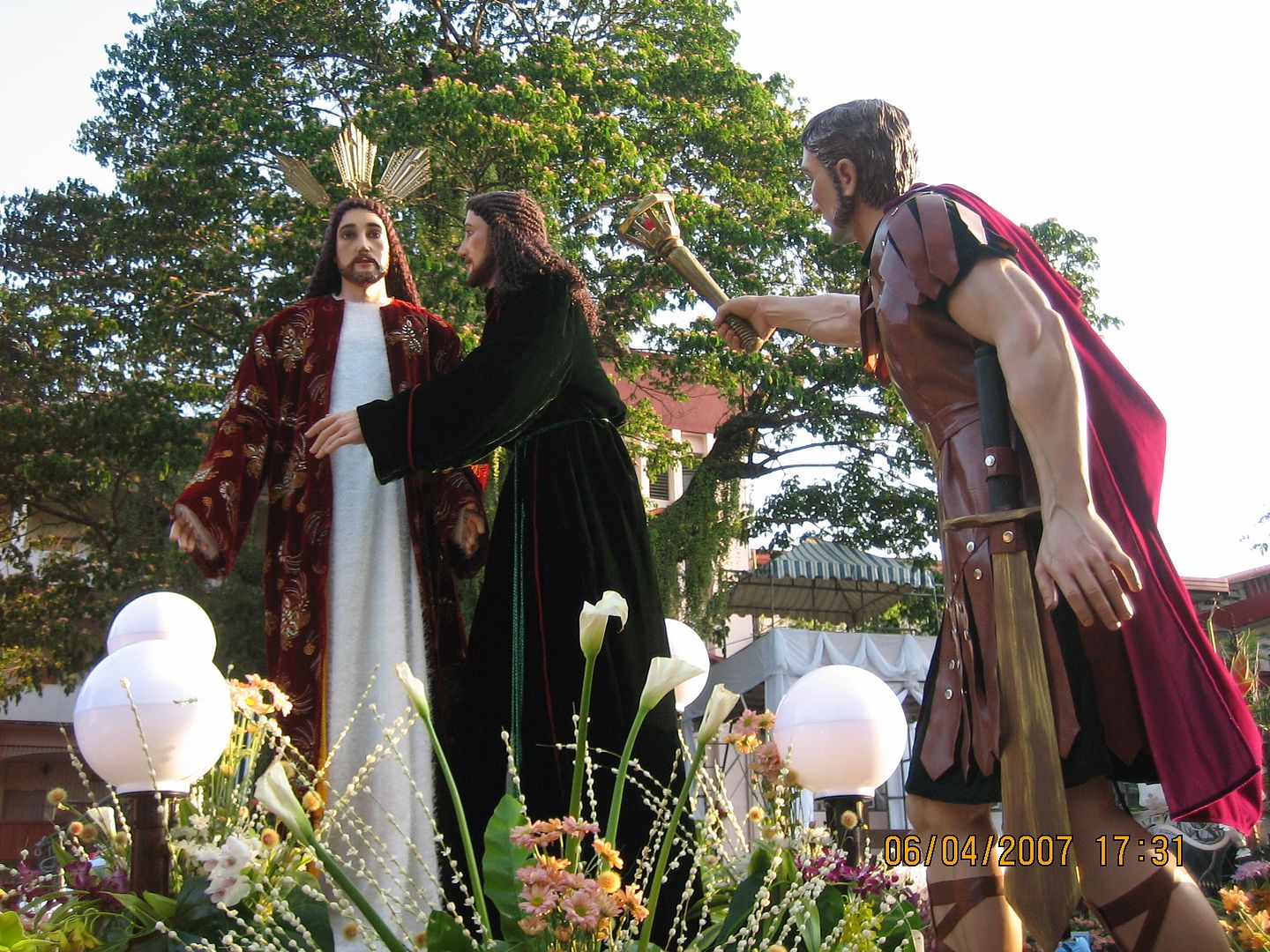From our immediately previous SS-Files expedition, we cross the Angat River to San Rafael. Founded as a separate municipality from its neighbour on the other side, Baliwag, in 1750, sometime in its history the old church passed into the hands of the relatively obscure order of the Hospitallers of Saint John of God. Therefore, the parish is dedicated to the order’s patron, San Juan de Dios
although the town’s name-saint is not forgotten.
San Rafael
where the Cyrene gets his own embroidered clothes and a gold headband, and the Roman soldier thankfully ignores the spaghetti noodles that apparently formed part of their uniform in Biblical times.
There was also an Agony in the Garden with a grown-up Angel
Perhaps she’s disappointed that this beautiful antique-looking metal-on-wood carroza belongs not to her
There was also a rather primitive-looking Paciencia, and this being Bulacan, unsuccessfully attempted to mask its folk appearance by opting for the sampaguita vendor look.
Finally, we come to the Santo Entierro.
When I was younger, I remember seeing this image’s old calandra parked in the church yard – it was simple, low, and small, I recall. Today, a new calandra is in use, and while not much bigger or taller than the old one, it is definitely more ornate.
Original comments:
The town is historically significant for being the site of the Philippine revolution’s bloodiest battle, where on 30 November 1896, Katipunero General Anacleto Enriquez, a.k.a. Matanglawin, and about 800 mostly non-combatant Filipinos were massacred inside and around the church by Spanish forces led by Lieutenant Colonel Lopez Arteaga. A marker outside the church entrance commemorates this event.
It is said that after the fighting, blood inside the church was ankle-deep! The province’s historical organization also put up a helpful marker in English, like the Pilipino version thankfully avoiding any references to wading in pools of blood.
Another popular story amongst the older of the town's residents is that the famous episode in Noli Me Tangere of Sisa and her children Crispin and Basilio actually occurred in san Rafael. The young Crispin was a sacristan in the church in the 1880’s, where he was beaten to death by the parish priest, resulting in his mother Sisa going insane and walking the many kilometres all the way to Baliwag and other neighboring towns in search of her now-dead young son, all exactly as Rizal had written.
Today, the church is a nicely-preserved, evidently-old structure, with hardly any trace of its violent past. Apart from the images of San Rafael and San Juan de Dios seen earlier, one will also espy within its premises images of the Blessed Mother with the Holy Infant,
Saint John the Baptist,
Saint Martin de Porres, complete with dog,
and Saint Joseph.
The church also boasts a painted bas-relief set of Stations of the Cross. We sample it with Jesus Meets the Women of Jerusalem,
and the Second Fall of Christ.
For the first time in more than twenty-five years, I visited San Rafael Bayan during Holy Week. I wanted to view at least some of the thirty-four processional tableaux and images listed in the parish’s Holy Week printed programme, which I was able to obtain a copy a few weeks before.
I was early for the Good Friday Veneration of the Cross service, so I walked within the church plaza, anchored on the other side by the multi-story school building operated by the Saint Paul nuns, and looked around.
An early bird was the San Rafael's Last Supper. I guess it had to be, given its bulk.
It was at once longer and wider than most actual dining rooms, and the carroza’s width straddled two lanes of the typically modest farm roads in this town.
But no matter how I shot this processional tableau, from whatever angle, all I could see were the backs of the figures,
almost like they were avoiding me, the Holy Week paparazzo.
Well, let’s at least give them some credit for splurging on a fancy-pleated table cloth front, shall we?
Also on early standby, right outside the church’s side entrance, was the processional tableau of The Denial of Peter.
I’ll leave the imaginative and irreverent reader to work out what the Woman might be accusing Saint Peter of.
Immediately after the Communion Service, the other processional images and tableaux started ambling their way into the church grounds. First in was Saint John the Evangelist.
This is a relatively well-carved and –painted image that is sadly burdened with folksy embroidered garments and oversized tassles. Some living room window in some nouveau riche home somewhere has gone missing its furnishings, I think.
Next up is a Holy Woman whose identity wasn't indicated on the carroza, but based on the printed program that I had obtained previously, might just be Nuestra Señora de Soledad.
It’s just as well that we aren't sure who she is, I guess, since her red, purple, and blue garments make her look like some patriotic fairy godmother.
It was getting late in the day, and I was probably running low on sugar, because even if I don’t really like chocolate (I find it simultaneously too bitter and too sweet), I suddenly had a craving after seeing this.
Fortunately, this appetizing Pieta was perched high up on its flower-laden carroza. Otherwise, I would have snipped off a piece to chew on.
Up next was a tableau of the Burial of Christ. Generally respectable, though alternately folk and folksy in parts, I thought.
And stepping back, I thought the canopy was rather gratuitous, as were the reproduction antique lamp-lighting fixtures.
We return to the tassles-and-embroidery look with Simon of Cyrene Helps Jesus Carry His Cross
where the Cyrene gets his own embroidered clothes and a gold headband, and the Roman soldier thankfully ignores the spaghetti noodles that apparently formed part of their uniform in Biblical times.
A suitably pained-looking Christ is featured in the tableau of Christ Before Pilate.
Santa Maria Salome's carroza is generously decorated.
Although I’m not sure exactly what she’s holding – is that a bunch of wildflowers, or a worn-out feather-duster?
There was also a poorly-blocked Christ with the Samaritan Woman by the Well.
And, for The Entry Into Jerusalem, a skinny-legged Christ mounted on an amused donkey.
The images of the tableau of Christ Meets the Women of Jerusalem were folkishly-carved and –painted,
but at least their garments were classical and unpretentious
and the figures were fairly blocked and laid out.
There was also an Agony in the Garden with a grown-up Angel
and a slightly stiff-looking Betrayal of Judas
with a muscular Roman soldier.
There’s really nothing wrong about this Scourging at the Pillar
Except that that Jewish temple guard scourger is way too distant to do an effective job.
But I was sure to take note of the fine metal ornaments of this tableau’s carroza.
A chesty Mary Magdalene looks suitably sad.
Perhaps she’s disappointed that this beautiful antique-looking metal-on-wood carroza belongs not to her
but to a similarly antique-looking Veronica.
Also spotted was a slightly mannerist Crowning With Thorns
and a sleepy-looking Saint Martha.
Christ and the Penitent Woman seems to be a popular tableau in these parts.
There was also a rather primitive-looking Paciencia, and this being Bulacan, unsuccessfully attempted to mask its folk appearance by opting for the sampaguita vendor look.
I liked this Nazareno less for the image itself
and more for its antique or vintage metal-on-wood carroza (you can tell by now that this is my preferred type)
trailed by its generator-on-caboose.
The processional Calvario had a Crucifix that was securely supported by a couple of metal rods.
Unfortunately the Sorrowful Mother and Saint John were both decked out like Merlin the Magician.
As a devotional and artistic alternative, the processional line-up featured a life-sized classical-ornate Crucifix, complete with elaborate metal rays and cross-ends. And this being Bulacan, bunches of sampaguita garlands from the nailed hands are almost mandatory.
The town's processional image of the Dolorosa I found a bit peculiar, what with its dazed expression and upturned eyes, but then again that makes it quite remarkable. I suppose that it could still be an antique, from no later than the early years of the 20th century.
Finally, we come to the Santo Entierro.
The Dead Christ is an antique image, whose brown wig could not be secured in place even by its bejewelled chin-band.
When I was younger, I remember seeing this image’s old calandra parked in the church yard – it was simple, low, and small, I recall. Today, a new calandra is in use, and while not much bigger or taller than the old one, it is definitely more ornate.
And thus ends our survey of nearly all of the images and tableaux of the San Rafael Bayan Holy Week processional line-up. I couldn’t stay to wait for all the participants to arrive and for the procession to start, as I had to rush off to my family’s own parish in the same town, several kilometres away. That’s coming up next.
Originally published on 14 November 2007. All text and photos copyright ©2007 by Leo D Cloma. The moral right of Leo D Cloma to be identified as the author of this work has been asserted.
Originally published on 14 November 2007. All text and photos copyright ©2007 by Leo D Cloma. The moral right of Leo D Cloma to be identified as the author of this work has been asserted.
adlailara wrote on Nov 16, '07
Thanks for sharing.
I particularly enjoyed reading your comments!!! |
arcastro57 wrote on Nov 16, '07
I always look forward to reading these amusing reviews. I just wonder if you'll ever be invited back next year. Hahaha!
|
rally65 wrote on Nov 16, '07
Well, my great-grandparents are from San Rafael Bayan, and one of our ancestral homes is right across the church, so they may not have any choice in the matter. Ha ha ha.
|
jayroberto wrote on Nov 16, '07
May binabagayan talaga ang bordado at ang tassel. Hahaha. Bumagay naman sa San Juan, sa iba, hindi.
Baliwag naman. Hahahahahahahha. |
jvlian wrote on Nov 16, '07
arcastro57 said
I just wonder if you'll ever be invited back next year. Hahaha!
WAHAHAHAHA
HAHAHA AHHAHAHAHAHAHA sana hindi nila mabasa... or sana mabasa nga nila talaga.. ng maliwanagan sila? |
marvinne wrote on Nov 17, '07
haba-haba siguro pag ang baliwag naman ang ni-review ni leo..
hahahahahhaha!!! |
meisterguysmiley wrote on Nov 17, '07
I wonder if Leo has a Baliwag photo collection hidden somewhere. Naku, oo nga mahaba-habang review yon. Hehehe
|
jayroberto wrote on Nov 17, '07
Nako, maikli lang yun. Nakalagay lang dun, isang malaking PRETENTIOUS. Tapos, "The End" na. Haha.
|
rally65 wrote on Nov 19, '07
Walang binabagayan ang burdado at tassel, bukod sa kurtina ng mga karaoke restaurant sa China.
|
mafyxus wrote on Jan 17, '08, edited on Jan 17, '08
ohmygosh... u really did a good job. nwei, there's more story about the church, if ever youre gonna visit that magnificent place again i suggest you ask the locals and you'll be surprised about what they are going to say. that place used to be my school and i really really miss it and gosh i love that church. if i go back home the first place that im going to visit is my church, the place where i literally grew up and taught me to be a good kid. thank you very much. namiss ko tuloy.
|
rally65 wrote on Jan 18, '08
Hi, Katie -- thanks for visiting. What other stories about the church, apart from the massacre and the Sisa episode, did I miss? Please share!
|
mafyxus wrote on Jan 18, '08
something to do with the well. you know the rooms that are connected to the church, they said, theres a "well" and some of the teachers na experience un pagmumulto. and one thing is like when you at the roof and when you look down, you can see a well. something like that.
|
rally65 wrote on Jan 28, '08
I asked my cousin (who also studied in the school attached to this Church), and he told me that the story circulating from his schoolboy days is that the so-called "well" was actually a disused tunnel.
The tunnel ran from the side of the church to a private home's backyard some distance away, and this is allegedly how revolutionary forces who sought refuge in the Church were able to flee from the advancing Spanish troops. Unfortunately, he did not know if the existence of the tunnel could be directly verified today. We'll need to explore this further some time. |
japett wrote on Feb 11, '08
i want to have some contact person in paete laguna, magppaukit kme ng santo..
ad me sa friendster kubijr07@yahoo.com |
japett wrote on Feb 11, '08
i want to have some contact person in paete laguna, magppaukit kme ng santo..
ad me sa friendster kubijr07@yahoo.com |
japett wrote on Feb 11, '08
i want to have some contact person in paete laguna, magppaukit kme ng santo..
ad me sa friendster kubijr07@yahoo.com |
dude15d wrote on Jul 10, '08
www.sanrafael.gov.ph & mpdo_srb@yahoo.com.ph @ Friendster..
|
dude15d wrote on Jul 10, '08
thank you for ur data, il grab and use in our friendster.. thanks
|
dsgaviola wrote on Apr 4, '10
yung bang santa maria salome, 'to na ba yung nasa pangangalaga ng pamilya santos?
|
rally65 wrote on Apr 5, '10
dsgaviola said
yung bang santa maria salome, 'to na ba yung nasa pangangalaga ng pamilya santos?
Unfortunately I don't know who the owner is of that image.
|






























































No comments:
Post a Comment